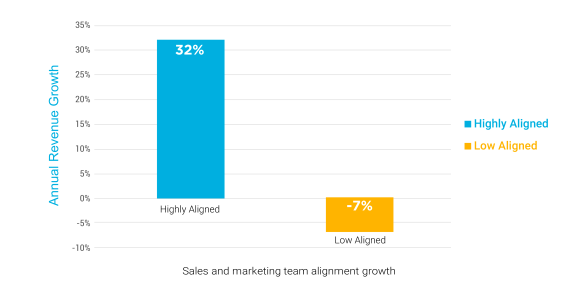Have you ever pondered the nature of a B2B marketing strategy, particularly concerning its application in marketing for tech companies? In the past, B2B marketing relied on separate departments for sales, marketing, and customer service, often leading to communication breakdowns and missed revenue targets. This siloed structure just wasn’t conducive to achieving a cohesive marketing approach.
What is B2B Marketing Strategy to Increase Brand Awareness?
A B2B marketing strategy tackles this head-on. It’s a framework designed to unify these departments towards a singular revenue generation objective. This strategy creates a cohesive approach by fostering better communication and overcoming the challenges of separate teams. It synchronizes your organizational vision, leadership, go-to-market strategy, and revenue plans, ultimately leading to a streamlined and effective path to achieving your business goals, including enhancing and measuring brand awareness strategy.
According to a Forrester Research report, companies with highly aligned sales and marketing teams experience an average of 32% annual revenue growth, while those with poor alignment see a 7% decline in revenue.

Maximizing Benefits Through Integrated Revenue Organizations
An integrated revenue organizational structure serves as the cornerstone for elevating B2B enterprises to new heights of success. It encapsulates a multitude of advantages that not only refine internal operations but also profoundly impact the end-to-end customer journey and revenue outcomes.
Customer-Centric Approach
An unwavering commitment to customer satisfaction and loyalty is at the core of this integrated setup. Here’s how:
Unified customer experience (CX): Integrated teams aim to deliver a seamless and consistent customer experience across every touchpoint, facilitating the transition from Brand to demand. This coherence in service and engagement enhances brand perception, and customer satisfaction, and drives successful account-based marketing initiatives through B2B brand awareness campaigns and effective brand awareness strategies.
360-degree view: Sharing customer data and insights among departments offers a comprehensive understanding of customer needs and preferences. This holistic perspective empowers tailored solutions and personalized interactions, cementing stronger client relationships by measuring B2B brand awareness campaigns.
Cross-Functional Collaboration
Integrated revenue teams thrive on collaboration and shared objectives, fostering a culture of unity and collective success:
Shared goals: Alignment toward common objectives—augmenting revenue, enhancing customer satisfaction, or maximizing customer lifetime value—ensures a synchronized effort across departments.
Frequent communication: A culture of open communication and information sharing permeates the organizational structure. This free flow of insights nurtures innovation and informed decision-making.

Technology Integration and Efficiency
Leveraging technology is pivotal in enhancing operational efficiency and agility:
Unified tech stack: Implementing integrated tools and platforms facilitates seamless data sharing and collaboration across departments. This unified approach streamlines operations and amplifies productivity
Automation: By harnessing automation, teams optimize workflows and processes, fostering increased efficiency and a more cohesive working environment.
Agile Strategies and Responsive Adaptation
The capacity to swiftly adapt and evolve is a hallmark of integrated teams:
Responsive decision-making: Integrated teams possess the agility to respond promptly to market fluctuations and customer feedback. This real-time responsiveness ensures timely adaptations and optimizations in B2B marketing.
Iterative improvement: An organizational culture steeped in continuous feedback loops drives iterative improvement. This ingrained process fuels innovation and drives perpetual enhancement.
Sales and Marketing Alignment
Aligning sales and marketing efforts is pivotal to driving cohesive revenue strategies:
Shared metrics: Synchronized performance metrics, such as lead conversion rates, customer acquisition costs, and revenue targets, align sales and marketing teams toward common objectives, facilitating a cohesive go-to-market strategy.
Joint planning: Collaborative planning sessions ensure a harmonized approach, ensuring sales and marketing efforts are complementary and coordinated. Joint planning sessions for B2B campaigns guarantee a harmonized approach to reaching potential clients and maximizing revenue opportunities.
Customer Feedback Integration and Development Initiatives
The integration of customer feedback loops and skill development initiatives further bolster the integrated revenue organizational structure:
Closed-loop feedback: A systematic approach to collecting and sharing customer feedback across departments fuels continuous enhancement in products, services, and customer interactions, which can build brand awareness.
Training and development: Cross-training programs and skill development initiatives equip teams with a comprehensive understanding of various functions, fostering a more collaborative and knowledgeable workforce.
Conclusion
The shift from siloed B2B marketing structures to integrated revenue organizations marks a significant evolution in pursuing cohesive, customer-centric strategies that drive revenue growth. This modern approach emphasizes the importance of aligning sales, marketing, customer success, and other key departments towards enhancing customer satisfaction and loyalty, and a comprehensive brand awareness strategy, thereby fostering substantial revenue increases.
The benefits of this alignment are that companies experience notable revenue growth when sales and marketing are closely integrated, transitioning seamlessly from brand-to-demand. Central to this strategy are the principles of cross-functional collaboration, leveraging technology for operational efficiency, agile response to market changes, and a steadfast focus on the customer experience. In addition, by adopting an integrated revenue organizational structure, B2B enterprises can realize improved internal operations, execute successful B2B brand awareness campaigns, ensure a seamless customer journey, and achieve superior revenue outcomes.
Learn how integrated B2B organizations can boost brand awareness and revenue growth. Connect with us for actionable insights and strategies to transform your marketing approach and achieve customer-centric results.




